Crickets often go unnoticed in the natural environment, but when they find their way into homes, they can become a noticeable nuisance. These insects are not only capable of creating an incessant chirping noise, often associated with quiet, rural nights, but they can also cause unexpected damage within a household. Although they are less notorious than termites or rodents, crickets can subtly harm fabrics, carpets, and other household items. With their penchant for chewing on a variety of materials, including wool, cotton, silk, and synthetics, especially those soiled with perspiration or food spills, crickets can degrade the quality of personal belongings.
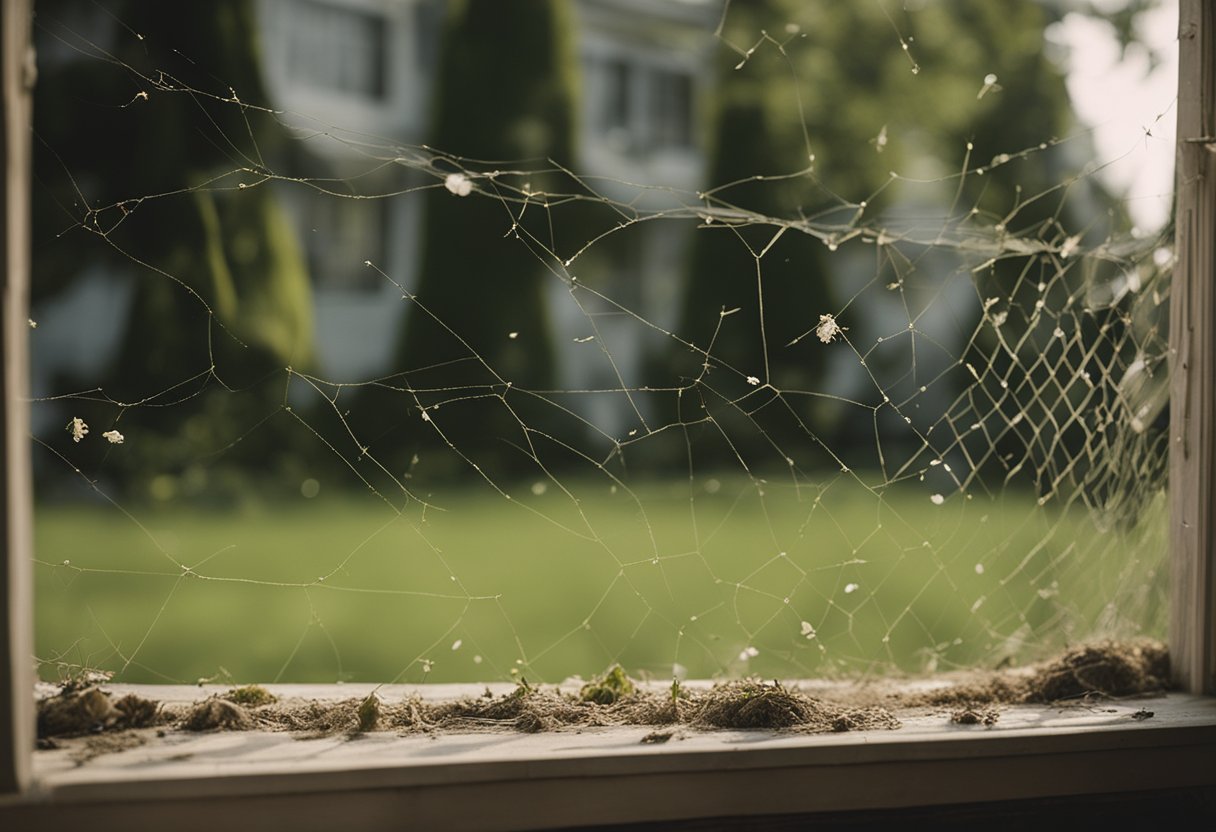
Beyond the direct damage to household items, crickets may attract other pests such as spiders, which can contribute further to pest-related problems. Their presence in homes is typically more common in colder months, seeking warmth and shelter in dark and moist places, making human dwellings ideal for their survival. The signs of cricket infestations, such as damaged fabrics or the appearance of their fecal matter, are indicators that homeowners should not overlook. Identifying and addressing cricket damage early can prevent extensive repairs and maintain the integrity of a home’s interior.
Understanding the behavior of crickets and their potential to cause harm is the first step in managing an infestation. While they might not pose a large threat individually, in significant numbers, their impact can be substantial. Homeowners should be vigilant in detecting the early signs of cricket damage and take appropriate measures to protect their homes from these unassuming yet potentially destructive pests.
Identifying a Cricket Infestation
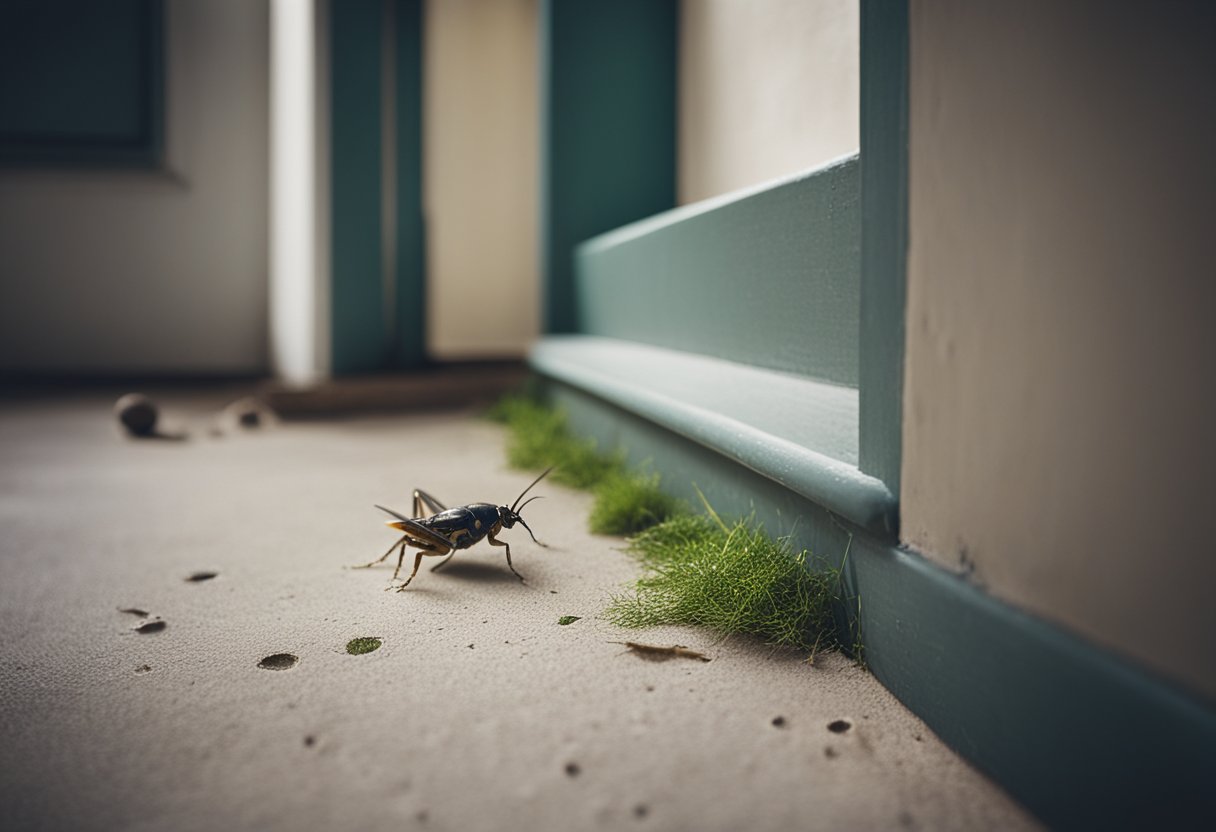
When suspecting a cricket infestation, one should look for visual indicators in conjunction with listening for telltale sounds that crickets typically make.
Visual Signs
An infestation may present visually in several ways. Firstly, the presence of crickets themselves within a home is a clear indicator. Crickets can range in size; for instance, house crickets are typically 16 to 22 mm in length and can be identified by their light yellowish-brown color as well as distinctive dark bands atop their heads. Field crickets are generally larger, growing more than 25 mm in length and are often brown or black.
Another visual clue is the sighting of cricket nymphs, which resemble adults but lack wings. One may also notice damage caused by their feeding on fabrics as they seek out food sources.
Sound Cues
Crickets are largely nocturnal and are renowned for their loud chirping, which is pronounced at night. This is especially true for male house crickets that create chirping sounds by rubbing their front wings together. The frequency and volume of this sound can indicate the level of activity or size of the cricket population within the home.
Cricket Biology and Behavior
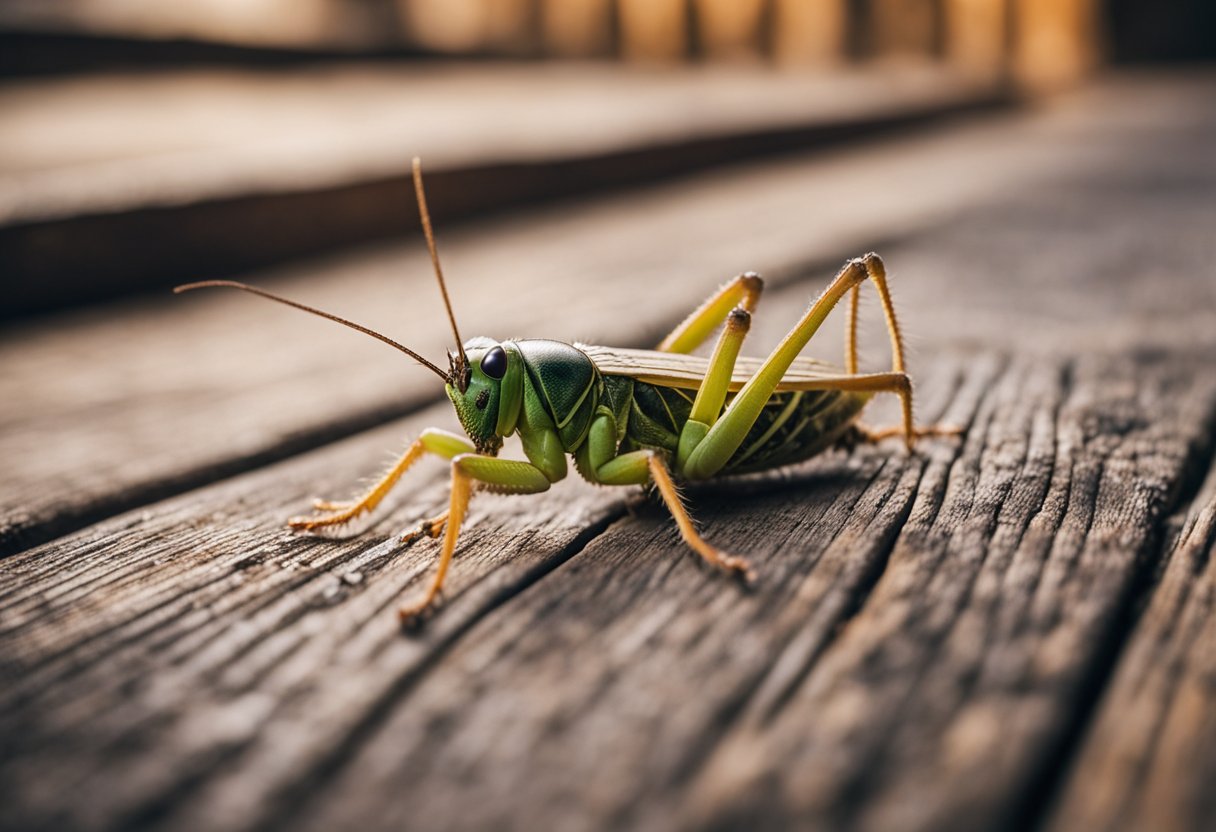
Physical Characteristics
Crickets belong to various species with certain common traits that help identify them. They typically range in size from 0.5 to 1.25 inches in length. House crickets usually have a light yellowish-brown color, while field crickets are characteristically black or dark brown. Both have a set of wings; the front wings being hardened and the back wings being membranous, which in some species extend like pointed tails. They are also equipped with long antennae, often as long as or longer than their body, which are used for sensing their environment.
Life Cycle
Crickets complete their life cycle starting with an egg stage, followed by nymphs, and finally reaching adulthood. Females lay their eggs in moist soil or plant matter, which provides an ideal environment for development. Their life cycle can be annual, with only one generation per year as seen in areas like Minnesota. They rarely reproduce indoors, but an understanding of their life cycle is important for effective control and prevention.
Habitat Preferences
In the wild, crickets prefer to live in warm, moist environments which provide them with the necessary conditions for survival and reproduction. They are primarily nocturnal and seek out dark and warm places during the day. Crickets are often found in fields, pastures, yards, as well as alongside roadways. House crickets, however, tend to invade homes seeking moisture and warmth. Indoors, they are attracted to moist and warm areas. Their propensity for chirping, especially by males to attract females, can be a telltale sign of their presence.
Common Cricket-Attracting Conditions
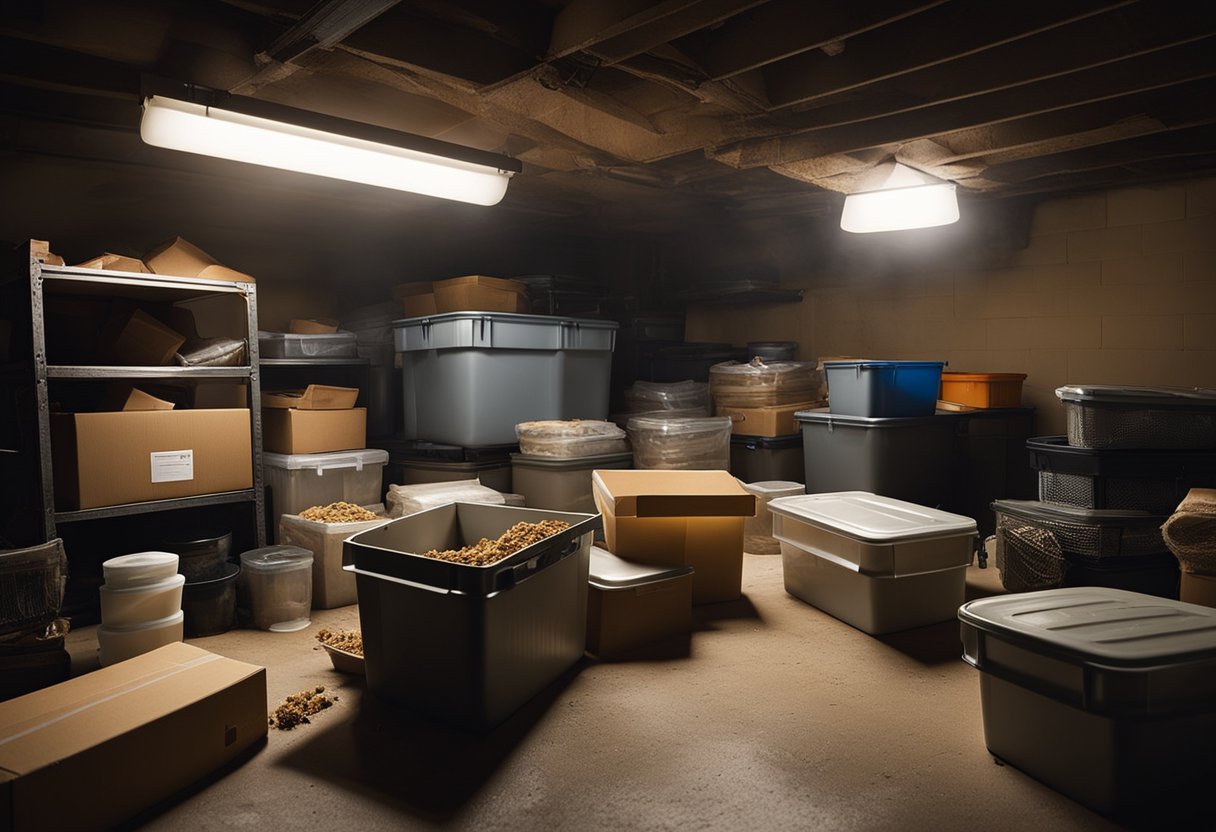
Cricket infestations in homes are typically not by chance; certain conditions can attract these insects and create an environment conducive to their presence.
Outdoor Factors
- Moisture: Crickets are drawn to moist environments, which means areas like woodpiles, overgrown vegetation, and accumulated organic material can be breeding grounds.
- Food Resources: An abundance of food resources such as plants, fruits, and piles of debris can provide crickets with the sustenance they need to survive and multiply.
- Shelter: Crickets find comfort in dark, protected areas. Dense foliage, crawl spaces, and even the undersides of rocks can serve as adequate shelter for house crickets.
Indoor Factors
- Damp Spaces: Areas within a home that tend to retain moisture, like basements and bathrooms, are particularly attractive to crickets.
- Warmth: They prefer warm conditions, so houses with ample heating or poorly insulated areas that trap heat can lure them inside.
- Fabric and Paper: Materials such as fabric and paper are not only sources of food for crickets but also potential nesting sites. Hence, cluttered storage areas can be problematic.
- Accessible Food: Crickets might be drawn to homes with readily available sources of food. This includes open containers of fruit, pet food, and even houseplants.
Cricket Damage to Homes and Possessions
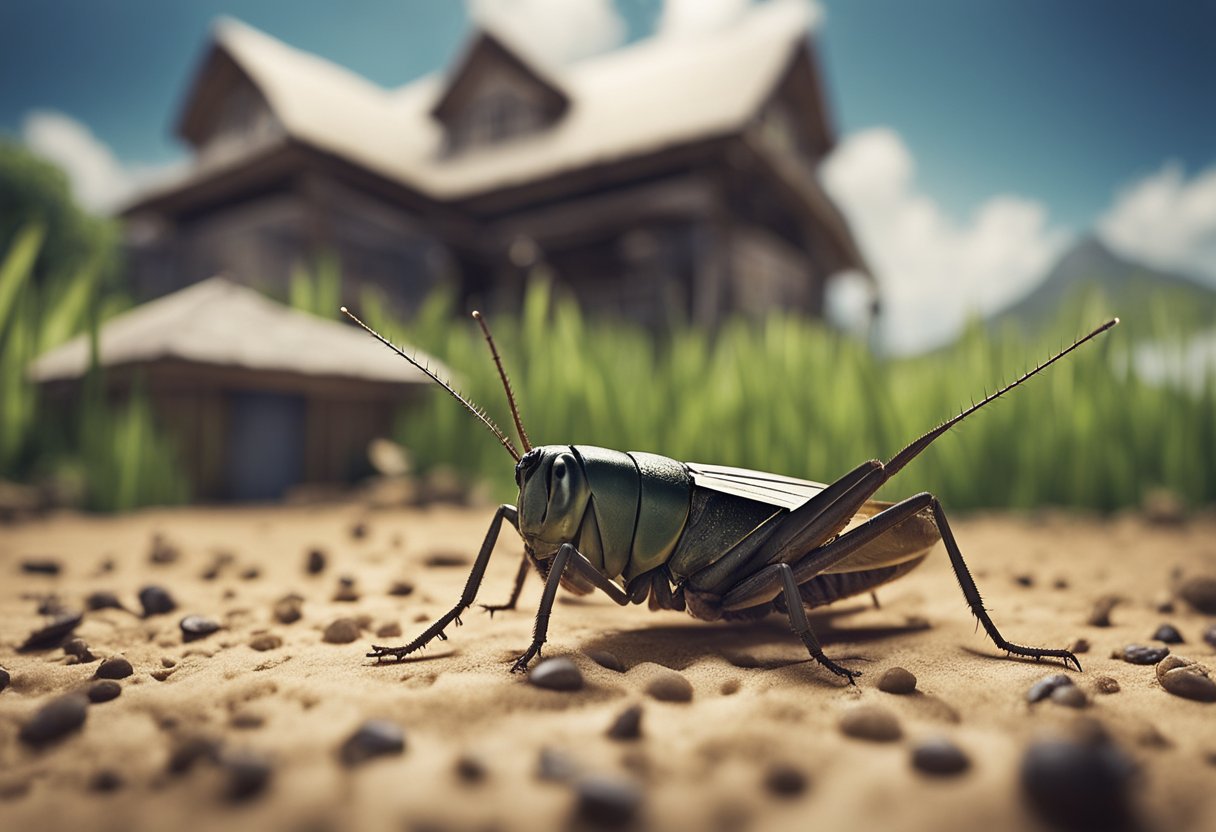
Crickets can cause a surprising amount of damage within homes, affecting both the structure and household belongings. Their mandibles can leave distinctive marks and deterioration on various materials.
Structural Damage
Cricket infestations may lead to noticeable harm to wooden elements of a home. With their strong mandibles, they can chew on wood structures, leaving marks on door frames, window frames, and even walls. This activity doesn’t just mar the surfaces, but could potentially weaken the structural integrity over time.
Damage to Fabrics and Plants
Household belongings, especially those made from fabrics such as wool, cotton, and silk, are susceptible to cricket damage. Crickets are drawn to these materials and can cut through them, leaving behind:
- Mandible marks: Small chewed areas and holes
- Surface roughness: Fabrics appear tattered due to fiber disruption
Additionally, the perspiration and body oils on fabrics can attract crickets, exacerbating the problem.
Preventative Measures and Solutions

To protect homes from cricket damage, it is essential to focus on preventing cricket entry and controlling cricket populations. Employing a strategic approach will safeguard against the potential harm these insects can pose to household items and structural components.
Preventing Cricket Entry
Homeowners should inspect the exterior of their homes for any cracks in the foundation, door frames, window frames, and masonry. Sealing these vulnerabilities is a crucial step in deterring crickets from entering the home. Here’s a focused approach:
- Seal Cracks: Use caulk or foam sealant to close any gaps in the building’s exterior.
- Door Sweeps: Install door sweeps to block the gap beneath doors.
- Secure Windows: Fix any broken window screens and ensure windows close tightly.
- Manage Moisture: Reduce moisture around the home, as crickets are attracted to moist environments like bathrooms, basements, and areas around leaky pipes.
- Move Woodpiles: Keep firewood and other debris away from the home’s exterior to eliminate cricket hiding spots.
Controlling Cricket Populations
Once entry points are addressed, reducing the existing cricket population is pivotal. The use of several control methods can dramatically lessen the number of crickets in and around a home.
- Glue Boards: Place glue boards in areas where crickets are frequently seen.
- Vacuum: Regularly vacuuming can remove crickets and their eggs from indoor spaces.
- Pest Control: If infestations are severe, professional pest control services may be necessary.
- Baits and Sprays: Utilize cricket-specific baits and sprays as directed, focusing on areas where crickets congregate.
Lighting can also influence cricket behavior. Minimizing outdoor lighting can help reduce the attraction for these insects since they are drawn to bright lights at night.

